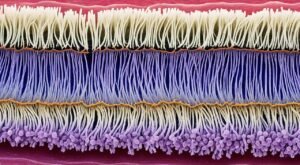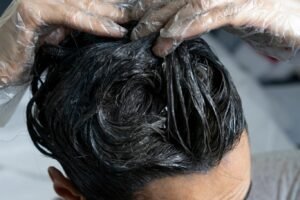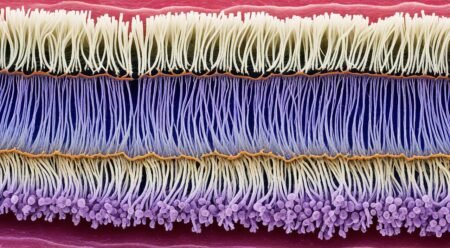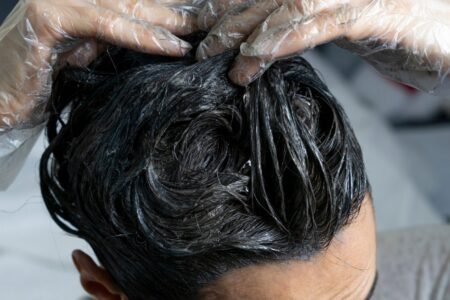“The secret of change is to focus all of your energy not on fighting the old, but on building the new.” – Socrates. In the world of hair loss treatment, this wisdom echoes true, especially when considering the revolutionary benefits of an FUE hair transplant. It’s not just about concealing what’s been lost, but about creating something new – a natural-looking hair restoration that can profoundly change how you see yourself and how the world sees you.
With the advent of FUE, or Follicular Unit Extraction, those wrestling with hair loss have a ray of hope. This cutting-edge technique offers a minimally invasive solution, brimming with FUE hair transplant benefits that go beyond mere aesthetics. So, let’s explore how this treatment can redefine the approach to hair restoration and give you back not just strands of hair, but strands of confidence woven back into the fabric of your being.
Understanding the FUE Hair Transplant Technique
As you explore the frontiers of hair restoration, the Follicular Unit Extraction (FUE) emerges as a sophisticated method of hair transplant surgery. It’s a game-changer for many struggling with hair loss, presenting a less invasive option with remarkable results.
What is FUE Hair Transplant?
The FUE Hair Transplant is a cutting-edge hair transplant procedure specifically designed to harvest and implant individual hair follicles, one by one. This meticulous approach employs precision instruments, ensuring a high survival rate of the follicles and promoting a natural appearance post-surgery.
The Process of Follicular Unit Extraction
The FUE process is a testament to medical advances in hair restoration. Let’s break down this hair transplant surgery into its essential stages:
- Evaluation of Donor Area: A surgeon assesses the back of your scalp to identify a robust donor area.
- Follicle Extraction: Individual follicular units are carefully removed using specialized equipment.
- Follicle Preparation: Once extracted, the follicles are inspected and prepared for implantation.
- Recipient Site Creation: Tiny incisions are made in the area requiring hair, prepared for the grafts.
- Implantation: The follicles are meticulously implanted to mirror the natural growth pattern of your hair.
The precision involved in this procedure promotes efficient healing and integration of the follicles into the balding areas, fostering hair growth that resonates with your body’s natural rhythm.
To contextualize the FUE technique further, consider the following table outlining the key components of the surgery:
| Stage | Description | Importance |
|---|---|---|
| Donor Harvesting | Extraction of hair follicles from the donor area. | Provides healthy grafts for transplantation, minimizes scarring. |
| Follicle Preparation | Grafts readied for insertion into thinning areas. | Ensures the vitality of follicles for successful growth. |
| Recipient Site Creation | Preparation of balding region for receiving grafts. | Critical for natural-looking hairline and density. |
| Implantation | Placement of grafts into prepared incisions. | Dictates the aesthetic outcome and density of hair post-procedure. |
With a focus on customized treatment plans and artistic execution, FUE hair transplant surgery has set itself apart as a premier choice for those seeking to restore their hair’s former glory.
Why FUE Hair Transplants Offer Superior Results
When it comes to hair restoration, achieving natural-looking results is the paramount concern for most individuals facing hair loss. An FUE hair transplant stands out as a remarkably successful method, delivering an aesthetic that blends seamlessly with your existing hair. Let’s delve into the distinctive qualities that make FUE a superior choice for those seeking to restore their hair’s former vitality.
The FUE, or Follicular Unit Extraction, process involves extracting individual hair follicles meticulously from your donor area. This technique, unlike older methods that remove a strip of scalp, leaves virtually no linear scars and allows for quicker healing. With FUE, you can wear your hair short without worry and feel confident that the results will look just like your natural hair pattern.
- Minimally Invasive Procedure: With FUE, you get a less invasive experience compared to traditional strip methods.
- Natural Hairline: Surgeons strategically place the follicular units to mimic your hair’s natural growth, achieving an undetectable finish.
- Quick Recovery Time: FUE’s precise application means fewer disruptions to your scalp, allowing for a faster return to daily activities.
While the benefits are clear, here’s a comparative view on why FUE may be the best match for your hair restoration goals:
| Feature | FUE Hair Transplant | Traditional Methods |
|---|---|---|
| Scarring | Minimal, almost invisible | Noticeable linear scars |
| Procedure Time | Longer, but more precise | Shorter, less detailed |
| Natural Look | Highly natural, seamless integration | Potential for less natural appearance |
| Recovery Period | Short, with minimal discomfort | Longer, with more post-surgical care |
| Long-Term Satisfaction | High, with lasting natural-looking results | Varies, sometimes requiring additional touch-ups |
Opting for an FUE hair transplant is more than a procedure; it’s a step towards reclaiming the confidence and appearance you deserve. By choosing this cutting-edge technique, you’re not just investing in your looks but also ensuring that the results you achieve are as close to nature’s craftsmanship as possible. Embrace the future of hair restoration with FUE, and enjoy the transformation that comes with great, lasting results.
The Ideal Candidate for FUE Hair Transplant
Choosing to undergo a hair transplant is a significant decision that requires understanding the spectrums of eligibility. Not everyone is an ideal candidate for an FUE hair transplant, and the renowned experts at leading hair transplant clinics carefully assess each individual’s unique circumstances. The assessment hinges on various medical and cosmetic factors, which are crucial for the success of the procedure performed by an experienced hair transplant surgeon.
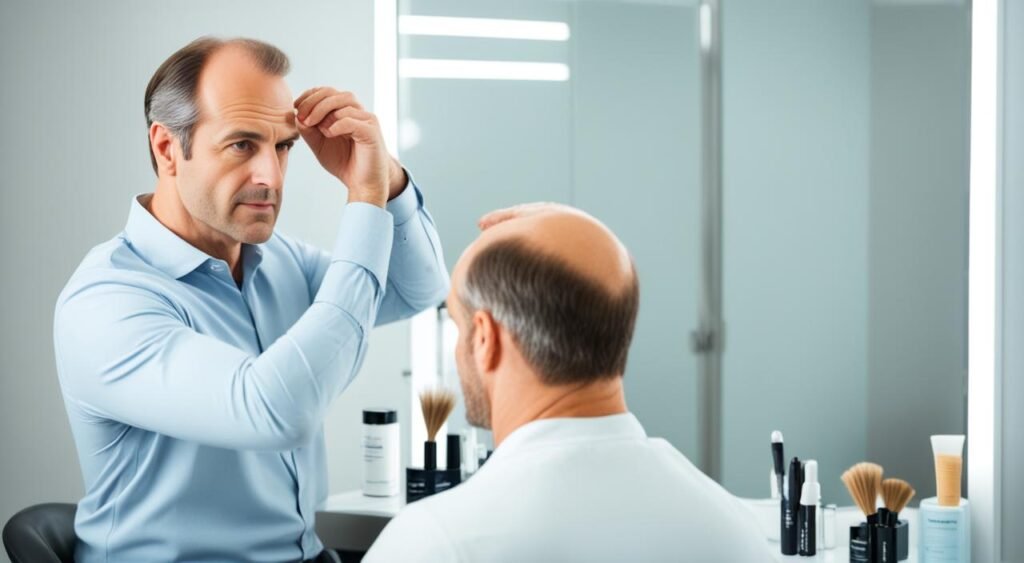
Assessing Your Suitability for FUE
When deliberating over the suitability for an FUE hair transplant, the first step is an evaluation by a professional. The quality of your donor hair, which includes its density and texture, plays an instrumental role in determining the potential outcomes of the transplant. Equally important is assessing the scalp’s flexibility and the donor area’s capacity to heal, a factor that varies from person to person. Below, find essential criteria used by surgeons to determine candidacy.
| Criteria | Description |
|---|---|
| Donor Hair Quality | Strength, diameter, and texture of existing hair in donor areas |
| Donor Area Density | Number of viable hair follicles per square inch in the donor site |
| Scalp Flexibility | The scalp’s elasticity to ensure minimal discomfort and scarring |
| Health Considerations | Overall wellness, including any underlying conditions that may affect surgery or healing |
Factors Influencing Hair Transplant Candidacy
Several factors play into the consideration of whether you are a prime candidate for this transformative procedure. Age, for one, has implications on hair growth patterns and progression of hair loss. Gender is also considered, as male and female hair loss can follow different trajectories and patterns. Lastly, the extent of hair loss as classified typically by the Norwood scale for men or the Ludwig scale for women will greatly influence both the approach and expectations for the hair transplant surgery.
- Age: Optimal age ranges for candidacy and how age affects hair loss
- Gender: Differences in male vs. female hair loss patterns
- Extent of Hair Loss: Classifications of hair loss levels affecting the strategy of follicular unit distribution
In conclusion, when pondering the prospect of an FUE hair transplant, it’s paramount to remember that individual nuances make each case unique. Therefore, consulting with a reputable hair transplant clinic and qualified hair transplant surgeon will provide you with the guidance necessary to make an informed decision based on your circumstances.
Preparing for Your FUE Hair Transplant Procedure
Embracing the possibilities that come with a follicular unit extraction (FUE) hair transplant requires thorough preparation to maximize the fue hair transplant benefits. As you embark on this transformative journey, following professional hair transplant recommendations is key. Let’s focus on the essential steps to prepare for your procedure and important discussions with your surgeon to align your expectations and ensure optimal outcomes.
Steps to Take Before Surgery
Intending to optimize recovery and results, your pre-surgery regimen is crucial. We advise adhering strictly to the guidelines provided by your clinic, but here’s a distilled list to get you started:
- Avoid any blood-thinning medications or supplements as advised by your doctor to reduce bleeding during the procedure.
- Halt the consumption of alcohol and cigarettes at least a week before the surgery – both can impair the healing process.
- Get a good night’s sleep the day before your appointment for your body to be in optimal condition.
- Do not cut your hair before the surgery; the surgeon needs to see the natural growth pattern for effective transplantation.
What to Discuss with Your Hair Transplant Surgeon
The consultation is a prime opportunity to address all your questions and concerns with your surgeon. Here are key points to cover:
| Discussion Point | Why It’s Important |
|---|---|
| Understanding the procedure | Gaining clarity on what the surgery entails helps in setting realistic expectations. |
| Reviewing your health history | This ensures the surgeon is aware of any conditions or medications that could impact the surgery or your recovery. |
| Post-op recovery and care | Knowing how to care for your scalp post-surgery will contribute to the success and longevity of the transplant. |
| Potential risks and complications | Being informed of the risks allows you to make an educated decision and recognize any post-surgical complications early. |
| Expected results | Each person’s results will vary; discussing what’s achievable for you specifically will help manage your outcome. |
Taking these steps seriously not only prepares you physically but also equips you with the knowledge and confidence needed as you look forward to enjoying the full spectrum of fue hair transplant benefits. Remember, the success of your hair restoration journey is a partnership between you and your surgeon, and it begins with meticulous preparation.
What to Expect During the Hair Transplant Surgery
Embarking on a hair transplant procedure can be a transformative journey towards reclaiming not just your hair, but also your confidence. As you step into the clinic set for your procedure, an air of expectation envelops you. The following information will provide a glimpse into what your day of hair restoration surgery will look like, helping to dispel any anxiety and prepare you for the experience ahead.
Upon arrival, you’ll be greeted by a team of professionals who are there to ensure your comfort and safety throughout the procedure. The surgical team will prep you, outlining the process once more and answering any last-minute questions you might have. Here’s an overview of what the day typically entails:
- Pre-Procedure Consultation: A thorough review of your procedure plan and an opportunity to discuss any concerns.
- Preparation: Your scalp will be washed and the donor and recipient areas may be marked for guidance during the procedure.
- Local Anesthesia: To ensure a pain-free experience, local anesthesia is applied to the areas of your scalp that will be worked on.
- FUE Process: The follicular unit extraction (or FUE) involves removing individual hair follicles from the donor area and meticulously implanting them into thinning regions.
- Monitoring: Throughout the surgery, your vital signs will be regularly checked to maintain optimal safety.
- Post-Procedure Briefing: After the grafts are securely in place, you’ll receive instructions on how to care for your scalp.
The sensation you might feel throughout the surgery can range from a slight pressure to minimal discomfort when the local anesthesia is applied. The procedure itself is lengthy, often taking several hours to complete, depending on the number of grafts being transplanted. It’s important to remember that every hair restoration journey is unique, with variability in the duration and specifics of the procedure.
The professionalism and expertise of your surgical team play a critical role in ensuring that the hair transplant procedure goes smoothly. Rest assured, they are trained to apply the precise techniques required for a successful and effective hair restoration process, dedicated to achieving results that feel and appear natural.
As your surgery concludes, you’ll be able to go home the same day. It’s normal to feel a sense of relief and excitement as you embark on the post-procedure phase, marking the beginning of a new chapter in your hair restoration journey.
Post-Procedure Care and Recovery
After completing your FUE hair transplant, the journey towards a fuller head of hair has just begun. It’s crucial to follow a regimented aftercare plan to maximize the fue hair transplant benefits and to ensure a smooth recovery. Proper care is essential to support the healing process and to foster the most effective hair loss treatment, leading to lasting results. Let’s explore the immediate steps to take post-procedure and the long-term care strategies that will help maintain the integrity of your hair transplant.
Immediate Aftercare Following FUE
Right after your procedure, attention to detail in aftercare can make all the difference. You’ll receive specific instructions from your clinic, which typically include guidance on how to handle swelling and manage any discomfort. Most patients experience minimal downtime, and adhering to these recommendations will help mitigate possible side effects and promote proper healing of both the donor and recipient sites. Keep a lookout for the following key aftercare elements:
- Medication for pain relief and to prevent infection
- Instructions on how to sleep to avoid disturbing the grafts
- Guidelines on how to wash your hair without causing damage to the transplant
- Recommendations on when you can return to your regular activities

Long-term Care for Lasting Results
Long after the initial recovery phase, your transplanted hair requires ongoing care to thrive. While FUE transplants are known for their natural-looking and durable results, your habits can significantly impact the longevity of the transplant. Consider these factors to maintain strong and healthy hair:
| Timeframe | Care Instructions |
|---|---|
| 1-3 Months | Avoid harsh chemical treatments and protect the scalp from excessive sun exposure. |
| 3-6 Months | Observe the growth of new hair and consult your surgeon if you have any concerns. |
| 6-12 Months | Regular check-ups with your hair transplant surgeon to assess progress and density. |
| 1 Year and Beyond | Continue with a healthy scalp regimen and use gentle hair care products. |
By investing effort into the care of your hair post-transplant, you are not only nurturing the recently transplanted follicles but also preserving the overall health of your scalp and hair. Remember, while FUE offers incredible benefits, the success of this innovative hair loss treatment greatly depends on your commitment to these aftercare practices.
Potential Risks and Complications of Hair Transplant Surgery
While hair transplant surgery is widely considered safe and effective for hair restoration, as with any medical procedure, there are potential risks and complications that you should be aware of. Being well-informed of these can help you have a transparent conversation with your surgeon and set realistic expectations for the outcome of your surgery.
Among the possible complications, some are relatively minor and easily managed, whereas others might require further attention. Here’s what you need to know:
- Infection: Although rare, there is a possibility of infection, which can typically be treated with antibiotics.
- Scarring: While FUE surgery is less likely to lead to noticeable scarring compared to other techniques, some level of scarring is inevitable.
- Bleeding: Some minor bleeding during and after the procedure is normal, but excessive bleeding can sometimes occur.
- Numbness: Temporary numbness is expected, but on occasion, it may last for several months.
- Swelling and Bruising: Swelling of the forehead or around the eyes can occur but usually subsides within a few days.
- Graft Failure: There is a chance that some of the transplanted follicles will not take hold and grow.
- Shock Loss: This temporary hair loss of existing hair can happen but typically grows back over time.
- Unsatisfactory Results: In some cases, the results may not meet expectations due to various factors such as poor graft placement or unnatural hairlines.
It’s paramount to select a qualified and experienced hair transplant surgeon to minimize these risks. During your consultation, don’t hesitate to ask about how these potential complications are handled and what steps are taken to prevent them. Remember that the success of your hair restoration journey vastly depends on the expertise of your surgeon and the care you take during the recovery process.
Comparing FUE Hair Transplant Cost and Value
When you’re considering an FUE hair transplant, understanding the dynamics of cost versus value is crucial. While the initial investment might seem significant, the longevity and quality of results speak volumes about the true value of the procedure. Let’s delve into the specific factors that constitute the overall cost and uncover how this translates into tangible value for you.
The Investment in Your Hair Restoration
Investing in an FUE hair transplant goes beyond the financial aspect; it’s a commitment to self-confidence and personal appearance. The cost of hair transplant surgery is not merely an expense but an investment in your long-term well-being and how you present yourself to the world. To fully grasp the hair transplant cost, it’s essential to consider the artistry, skill, and technological advancements that contribute to successful outcomes.
Understanding the Factors that Influence Cost
The hair transplant cost is influenced by several factors, including the clinic’s location, the surgeon’s expertise, and the extent of the treatment required. Each of these elements plays a critical role in shaping the overall price you pay.
- **Clinic’s Location:** High-end urban centers often have clinics that charge more due to higher operational costs.
- **Surgeon’s Expertise:** Experienced surgeons with a track record of high-quality results may command higher fees.
- **Extent of Treatment:** The number of grafts needed greatly affects the total cost—the more extensive your hair loss, the higher the number of grafts you’ll require.
While evaluating these factors, remember that the hair transplant value is reflected in the natural appearance and the durability of the transplant. It’s this long-lasting transformative effect that adds weight to the overall worth of the procedure.
In conclusion, while the upfront hair transplant cost may initially draw your attention, it is essential to fully assess the value of the results. A successful FUE hair transplant can provide an indelible boost to your self-esteem, with outcomes that last for years, defying the initial price tag with the incomparable hair transplant value it delivers.
Choosing the Right Hair Transplant Clinic
Undergoing a hair transplant is a significant decision that not only impacts your physical appearance but also your overall self-confidence. It is paramount that you select a hair transplant clinic and hair transplant surgeon that meet your expectations and medical needs. Below, find critical considerations to help ensure you partner with a reputable professional who can deliver the hair restoration results you desire.
When you’re investigating potential clinics, your first step should be to verify the qualifications and experience of the surgical team. Here’s what to focus on:
- Credentials of the hair transplant surgeon: Ensure they are board-certified and have a history of success in performing hair transplant surgeries.
- Clinic’s reputation: Look for testimonials from previous patients and before-and-after galleries to judge the quality of their work.
- Technology and techniques: Confirm that the clinic uses state-of-the-art equipment and the latest hair transplant methods.
- Initial consultation experience: Your first meeting with the surgeon should be informative and should make you feel comfortable and understood.
As important as it is to know what to look for, being aware of red flags is equally critical. Avoid clinics that:
- Lack transparency in pricing or pressure you into making quick decisions.
- Do not provide a thorough assessment during your consultation.
- Have limited or no patient testimonials and insufficient photographic evidence of their work.
By taking the time to thoroughly vet potential hair transplant clinics and surgeons, asking the right questions, and listening to your instincts, you’re more likely to enjoy a positive outcome that enhances your appearance and confidence. Remember, the success of your hair transplant lies in the hands of the professional you choose, so make this decision with careful consideration.
FUE Hair Transplant: Ensuring Natural-Looking Hair Growth
When you embark on the journey of a fue hair transplant, you’re not just investing in a fuller head of hair; you’re opting for a transformation that promises natural-looking hair restoration. With cutting-edge technology and meticulous techniques, FUE ensures that the new growth blends seamlessly with your existing hair, establishing a hairline that others will admire, but never question. The ultimate aim is to enhance your appearance without any obvious signs of intervention.
To preserve the authenticity of your restored hairline, FUE specialists employ tools and methods that consider the natural direction of your hair growth, ensuring each follicle is placed with precision. This meticulous attention to detail is why FUE stands out as a premier option for those seeking discretion and elegance in hair restoration. Moreover, the journey doesn’t end with the procedure; your dedicated care following the transplant will play a pivotal role in maintaining the health and appearance of your hair for years to come.
As you step forward with renewed confidence, remember that the value of an FUE hair transplant extends beyond the hair itself; it’s about the life-changing impact and the boost to your self-esteem. By providing you with a lush, natural-looking mane, FUE opens doors to new possibilities and allows you to face the world with a fresh perspective. Trust in the process, follow the guidance of your hair restoration team, and look forward to the long-term benefits that an FUE hair transplant can offer.
